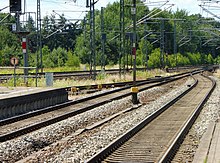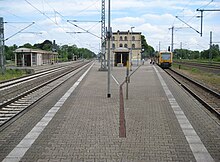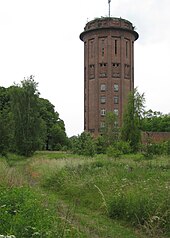Hagenow Land train station
| Hagenow Land | |
|---|---|
|
Schwerin tracks, water tower, post office and reception building
|
|
| Data | |
| Location in the network | Separation station |
| Design | Wedge station |
| Platform tracks | 4 (1a, 1b, 2, 3) |
| abbreviation | WHL |
| IBNR | 8010156 |
| Price range | 5 |
| opening | October 15, 1846 |
| Profile on Bahnhof.de | Hagenow_Land |
| Architectural data | |
| Architectural style | Late classicism |
| location | |
| City / municipality | Hagenow |
| country | Mecklenburg-Western Pomerania |
| Country | Germany |
| Coordinates | 53 ° 24 '48 " N , 11 ° 12' 57" E |
| Railway lines | |
|
|
| Railway stations in Mecklenburg-Western Pomerania | |
The Hagenow Land railway station is a railway junction in Mecklenburg-Western Pomerania that went into operation on October 15, 1846. It is located about two and a half kilometers southeast of the center of the small town of Hagenow along the parallel Eisenbahnerstraße .
The addition to the name “Land” in the official station name indicates on the one hand the location outside the village, on the other hand it serves to distinguish it from the station “Hagenow Stadt” located 3.5 kilometers away in the center of the city (until 2010: only “Hagenow ").
History of origin
The fact that the Berlin-Hamburg railway was operated with a 20-kilometer detour via the comparatively small town of Hagenow, which at the time had 3400 inhabitants, resulted from the negotiations between the five states of Prussia , Mecklenburg-Schwerin , Denmark , Lübeck and Hamburg about the construction of the Route. The Mecklenburg side under Grand Duke Friedrich Franz II undertook in a state treaty signed on November 8, 1841 to subscribe half of the share capital and was thus able to achieve a route that passed close to the Mecklenburg residence in Schwerin . The Hagenow train station was intended to connect Schwerin (and later Rostock and Wismar). Original plans included a train station close to the city. In the end, however, due to the more favorable gradient conditions, the responsible committee determined “that a line from Berlin […] touching Grabow, Ludwigslust, but leaving Hagenow and Boitzenburg at a distance of 5/8 miles on the right and 1/3 mile on the left […] each is preferable to other lines ”.
On October 15, 1846, the Berlin-Hamburg railway to Boizenburg , then still called Boitzenburg , opened. Before that, on March 10, 1846, the Mecklenburg Railway Company received the concession to build a line from Hagenow to Schwerin.
meaning
The Berlin-Hamburg Railway was the first railway line on Mecklenburg territory. The Hagenow train station, together with the Ludwigslust and Grabow (Meckl) train stations, which also opened on October 15, 1846, and the stations in Brahlstorf and Boizenburg are among the oldest in Mecklenburg. When the railway line to Schwerin was opened on May 1, 1847, the station became the first railway junction in Mecklenburg. After the takeover under the law of May 17, 1884 , the Berlin-Hamburger-Bahn was owned by the State of Prussia , while the line to Schwerin became part of the Mecklenburg Friedrich-Franz Railway . Even after the establishment of the Deutsche Reichsbahn , both lines were managed by different Reichsbahndirectors until 1945 .
Between 1894 and 1896 the railway line, also known as the Kaiserbahn , went into operation in several stages via Ratzeburg to Oldesloe . It was intended to shorten the Kaiser’s way from Berlin to the headquarters of the Imperial Navy in Kiel . The city of Hagenow received another station on this route near the city center, which took the name Hagenow . The original Hagenow train station has since been referred to as Hagenow Land . Until 1945 Hagenow Land was an important long-distance train station. Almost all D-trains between Berlin and Hamburg stopped there, plus some D-trains between Berlin and Kiel via Ratzeburg and Lübeck .
After the Second World War, the route to Bad Oldesloe on the German-German border was interrupted behind Zarrentin . The Berlin-Hamburg railway also lost its importance due to the border. From the 1960s to the late 1980s, a single pair of express trains stopped in Hagenow Land, an interzonal train from Hamburg to Dresden and later to Leipzig.
The Hagenow Land train station remained insignificant for the long-distance traffic from Berlin and Schwerin to Hamburg, which increased significantly after 1990. Long-distance trains have only stopped sporadically in the station since 1992, and not at all since 1996.
Passenger traffic to Zarrentin was discontinued in 2000, only the Hagenow city station is used. The Hagenow Land station is the more important of the two stations in the city as a hub station and stop of the regional express line RE 1 from Rostock via Schwerin and Hamburg (route book route 100). Passenger trains operated by Ostdeutsche Eisenbahn GmbH (ODEG) run on the course book route 172 from Hagenow Stadt via Hagenow Land, Ludwigslust to Neustrelitz . Connections to Berlin always require a train change, usually at Ludwigslust station. Freight traffic no longer serves the Hagenow Land station.
Routing
Coming from Ludwigslust, the Berlin – Hamburg railway runs northwest towards Hagenow Land and, shortly before the train station, makes a wide, almost 90 ° curve, which runs past the wedge-shaped platform system to the southwest towards Boizenburg .
The pair of tracks from the direction of Schwerin runs in a straight line from the north-east towards the north-western side of the station of Hagenow Land and, behind it, unites with the line towards Hamburg, maintaining the same direction. There is a scale map from 1879 of this track system and the location of the town of Hagenow.
About 300 meters behind the point where the lines from Schwerin and Ludwigslust converge, the single-track line branches off in the direction of Zarrentin via the Hagenow Stadt station in a narrow 90 ° curve to the northwest. Originally the route of the " Kaiserbahn " continued via Ratzeburg to Bad Oldesloe .
Platform systems
The central, 200-meter-long platform with the station building runs at an acute angle from the junction of the Hagenow Land – Schwerin railway from the main Berlin-Hamburg line between the two diverging tracks and widens to 38 meters across at the end. In this form, the Hagenow Land station represents the ideal type of a wedge station . Track 1 is on the south-eastern ("Prussian") side, and track 2 on the north-western ("Mecklenburg") side. The opposite track on the line from / to Schwerin has its own, equally long but considerably narrower platform 3.
The main tracks on the Berlin – Hamburg line no longer have their own platform; instead, track branches lead from and to the main line via switches from and to the platforms of the wedge station.
A pedestrian tunnel connects the wedge platform with the outer platform with track 3 of the Hagenow-Schwerin line. This platform is freely accessible at the same level from the adjacent parking lot with the bus stops .
building
The station building has a two-story central section with three-story, larger wing structures on both sides. In terms of style, the consistent use of round arches makes it stand out from the simple straight lines of most of the other historical buildings on the Berlin-Hamburg Railway.
In the south-west of the building there is a flat building, in which there was the commission room and the princely lounges, the so-called waiting rooms for noblemen. A “princely chair” with an imperial brand has been preserved from the furnishings; it was installed in the rooms before 1876. The Dehio Handbook of German Art Monuments says about the building: "Erected in a formal manner based on Florentine Renaissance palaces ", "with components of different heights, a symmetrical structure and horizontally structured with sill cornices , arched windows of decreasing height each storey and a protruding main cornice ". It is assumed that the building "... was built according to a design by F. Neuhaus."
But even if the master builder and architect Friedrich Neuhaus , who was in charge of the construction of the entire Berlin-Hamburg railway, was demonstrably involved, for example, in the design of the Hamburger Bahnhof in Berlin , “[...] there is no information from a person responsible for the design for almost all other stations [...] , […]. However, one can assume with some certainty that Friedrich Neuhaus at least provided specifications for all stations on the route, which were then further developed and implemented by local builders ”. The building is a listed building, and a corresponding plaque is attached to the north side.
There are modern weather protection systems for passengers on both the wedge platform and the outer platform on platform 3.
A few meters from the reception building on the historical side “Bahnhofsvorplatz” there is a building with the raised inscription “Post”. It is similar, but lower and stylistically simpler, but has roughly the same footprint as one of the side wings of the reception building. This building is also a listed building. The station building was sold in August 2014. The private owners live in the station building and have set up a bistro there.
Former railway facilities
As the starting point of the first railway line under the direction of Mecklenburg-Schwerin, the Hagenow Land station was equipped with the usual operating facilities for the maintenance and repair of the vehicles. These are still available as of 2012, but in a badly dilapidated condition. There was a railway depot that was located on the inside of the curve leading from Ludwigslust. It had, among other things, a roundhouse with ten stalls and a turntable . Another, very similar building not far from it suggests a second roundhouse, but all traces of the turntable that was presumably once present as well as the siding have disappeared. There are additional siding and sheds on the premises. A former, approx. 30 meter high railway water tower is located near the station building. The eleven-story, expressionistically designed brick building was erected in 1926. It is also in a bad state of disrepair and is a listed building.
In the 1990s, there were four more sidings parallel to the main tracks in the direction of Schwerin, as well as a bridge-type signal box over the tracks at the southern end where the parking lot is today on the western side . A semi-automatic marshalling yard with a series of electrodynamic mountain track brakes (EDG) and an adjoining track harp with 10 directional tracks, each with an EDG directional brake (type FEW-Blankenburg), was built on the south side of the station in the 1980s . After the reunification of Germany, the upstream border marshalling yard was dismantled.
After 1900, two-story, mostly four-family houses with small animal stalls and allotments were built for the railroad workers across and along Hagenower Strasse. In 1953, the railway workers' club, Fritz Heckert , was built and a sports field with a shooting range was created for cultural life in the Hagenow railway station .
Hagenow Stadt train station
The station in the center of Hagenow was built in 1894 with the name "Hagenow" and has been listed in the official timetables as "Hagenow City" since 2010. It consists of a small reception building with catering facilities and a long shed built on the southern side, which was used for goods traffic. At the rear of the building facing the city is the main platform and another island platform for the double-track system. Between the city station and the single-track junction from the line to Schwerin, the track system expands to four to five parallel tracks at two points, which are no longer used. The reception building and the goods handling building are under monument protection.
After the division of Germany, the trains on the route in the direction of Bad Oldesloe only ran to Zarrentin . Passenger traffic on this connection was discontinued in 2000. The Hagenow Stadt station has been used again by the East German Railway since 2002 as the end point or start of the railway line towards Ludwigslust or Parchim .
Web links
- Location and tracks of the station on the OpenRailwayMap
- History of the Mecklenburg Railways (PDF; 577 kB)
- Berlin-Hamburg Railway, Classicist station buildings in Brandenburg (PDF; 5.2 MB)
- Website with pictures from the 1990s
Individual evidence
- ↑ Frdr. Soltau: Latest conditions and events in Mecklenburg: Thl. 1. The time of the revolutionary movement u. their history. 1843–1850 , C. Kürschner, 1851, page 19 ( Google eBook, )
- ^ Die Eisenbahnen Deutschlands , Volume 6 by Friedrich Wilhelm Reden (Freiherr von) , Section C: The Railways in the Grand Duchies of Mecklenburg , pages 1944–1953 ( Google eBooks )
- ↑ quoted in: Peter Bley, 150 years of railways Berlin - Hamburg . alba, Düsseldorf 1996, ISBN 3-87094-229-0 , p. 21
- ↑ Map 2533 Hagenow ( Memento from August 28, 2018 in the Internet Archive ) at
- ↑ a b State of Brandenburg, Ministry of Infrastructure and Regional Planning: Berlin-Hamburg Railway, Classicist station buildings in Brandenburg (PDF; 5.2 MB)
- ↑ Peter Schmedemann, Menno Dirks: Next stop: Hagenow Land! On the history of a train station between 1846 and 1933 . In: Henry Gawlick for the Museum Hagenow (ed.): Leaves on the cultural history and folklore of Southwest Mecklenburg . No. 7 . Eichenverlag Schwerin, 2009, p. 12 .
- ↑ a b c Georg Dehio : Handbook of German art monuments. Mecklenburg-Western Pomerania , Deutscher Kunstverlag, revision, Munich / Berlin 2000, ISBN 3-422-03081-6 , p. 237
- ↑ a b c d List of monuments of the Ludwigslust district
- ↑ Hagenower Kreisblatt, August 13, 2014: The station is now sold ( memento from September 20, 2016 in the Internet Archive ), accessed on September 20, 2016
- ↑ Lots of new ideas for the old train station. In: Schweriner Volkszeitung, July 11, 2017, online
- ↑ Annette Schuhmann: Cultural work in the socialist enterprise: trade union educational practice . 36 page 188.Böhlau Verlag, Cologne 2006, p. 317 .
- ^ History of the city of Hagenow










